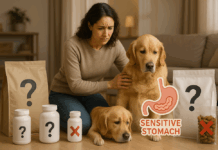Last Updated on July 23, 2022 by Dogs Vets
Dog Treats: What to Look for and What to Avoid
Dogs, like humans, require daily amounts of specific vitamins, minerals, proteins, carbohydrates, fats, and water to carry out their everyday activities. Thus, ensuring that the food you give your dog contains the appropriate proportions of various nutrients is essential.
Most brands contain the bare minimum of nutrients a dog requires. However, it is essential to note that not all dogs have the same nutritional needs.
For this reason, companies that make food for dogs put a lot of effort into developing the precise ingredients that go into their products.

One example is obesity, mainly if the treats are high in fat and contain many calories that do not contribute to your pet’s energy needs.
When you purchase dog treats, you need to know what you should be on the lookout for and what you need to avoid.
What to Look for?
With your dog forming part as one of your primary sources of comfort and best companion, it can be exhausting trying to keep up with their energy, especially as a pup.
On occasions where you need a break, give them good puppy treats to occupy their time and keep them distracted. But rather than tossing your dog just any food, you may want to consider the types and amounts of treats you give your dog.
The food that you give your dog contains specific nutrients for a reason. Your dog wouldn’t be able to keep its muscle strength, repair and build muscles, bone, and teeth, undertake everyday activities with ease, or fight off the infectious disease if it did not receive proper nutrition.
- Dog treats consisting of organic ingredients are preferable. This is because they are more difficult to contaminate with undesirable substances. Also, organic ingredients are subject to a higher quality control inspection. The more significant the proportion of organic components, the better.
- Natural and food-based sweeteners should be used minimally, if at all. If you’re looking for a sweetener that’s not artificial, try apple sauce, honey, or molasses in the ingredient of your dog’s treat, as it is much more preferred.
- A natural preservative should be used if a treat is preserved. As such, vitamins C and E are effective and safe choices as preservatives. Moreover, some treats need no preservatives, so store them properly and consume them as soon as possible.
- A substantial amount of animal protein is the aspect of a meaty treat that stands out the most. And the use of fewer ingredients in meat-based dog treats is preferable.
What to Avoid?
If there are things you should look out for in dog food, there are also things you must avoid. First, make sure that the ingredients list of the dog treat that you’ve purchased does not include any of the following:
BHA
It is a substance used to preserve fats and oils after they have been processed. BHA is permitted in certain European countries, Canada, and the United States, but only in low concentrations.
A tiny amount, however, can severely threaten your dog’s health. Humans are at risk of developing cancer from exposure to this chemical, according to the Centers for Disease Control (CDC). However, when given to dogs, it could be just as lethal. On top of that, it can aggravate your dog’s eyes and skin and harm their kidneys and liver.
White Flour
This ingredient is a simple carbohydrate that functions as a filler and binding agent in certain dog foods. The procedure of bleaching wheat removes the vast majority of the plant nutrients that were initially present in the grain.
This flour can dramatically decrease or increase the blood sugar levels of your dog after consumption. Moreover, it only satisfies them for a brief period before they become hungry again. When this occurs, your dog consumes as much food, increasing its likelihood of developing obesity and diabetes.
Artificial Food Coloring
Although adding colors to food for people can be a lot of fun, doing so to food for animals is rarely beneficial.
Farmed Salmon
Both humans and dogs can benefit significantly from the omega-3 fatty acids that can be found in salmon. This is common knowledge. But here’s the catch: feeding your dogs the wrong sort of salmon could potentially harm them.
Nitrites/Nitrates
Nitrites and nitrates make up a bunch of chemicals put into use as preservatives in food products to have a longer shelf life. It is frequently used to produce ready-to-eat meats such as ham, bacon, sausages, hotdogs, and deli meats. But, on the other hand, if consumed in large quantities, it may harm your dog’s health.
Final Thoughts
Consider the ingredients in the food you plan to buy for your dogs when making your treat purchases. It’s essential to keep some of the ingredients you should be on the lookout for and the ingredients you should avoid to keep your dog safe.
Fact check…
We hope you enjoyed this article… What are your thoughts about Dog Treats?
Рleаse let us knоw yоur thоughts in the соmments seсtiоn. Feel free to share with us in the comments section below.

















